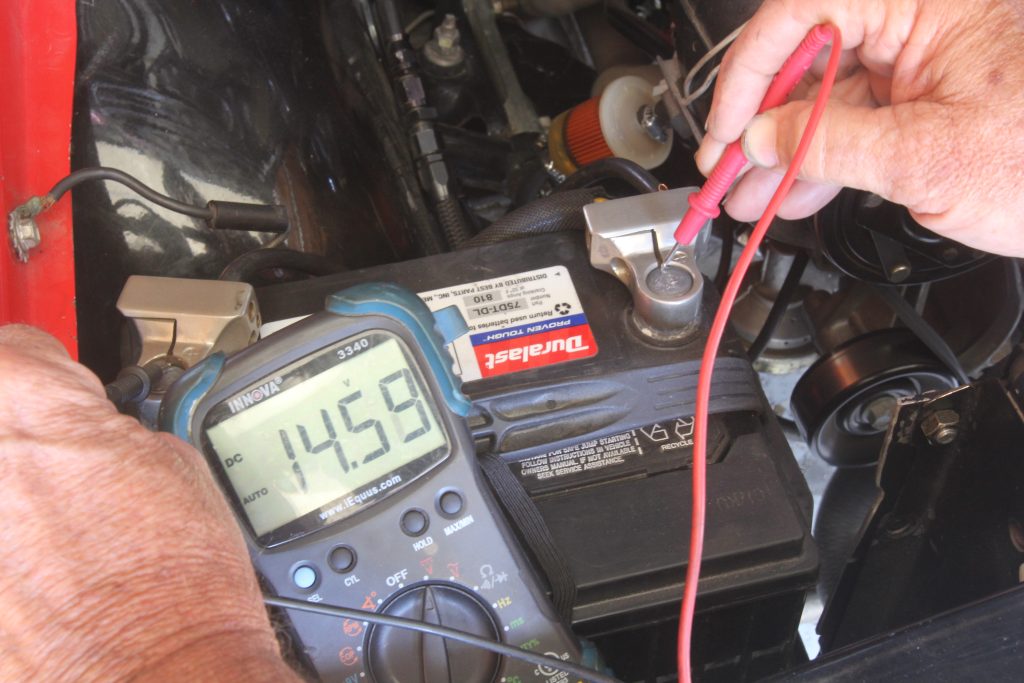I have a 1970 Mustang and I’m trying to decide what alternator amp rating I need. The only electrical demand above the normal stock stuff is I have a three-row aluminum radiator with two big electric fans. The car will also be equipped with an A/C system. Would an 85 amp alternator be good enough or would I need more?
F.S.
There are a couple of details that are important to know in order to choose the proper output alternator. First, alternators are rated at maximum power. So an 85 amp alternator will probably only put out about 60-65 amps at idle based on variables like the pulley ratio for the alternator from the accessory drive. As a rule of thumb, most street engines use a minimum of a 3:1 pulley ratio for the alternator.
Calculating the pulley ratio is not difficult. You merely divide the diameter of the crankshaft (drive) pulley by the diameter of the alternator (driven) pulley.
So if the crankshaft pulley is 7.5 inches in diameter and the alternator is 2.5 inches, then the pulley ratio is 7.5 / 2.5 = 3:1. If the ratio is higher (either the alternator pulley is smaller or the crank pulley is larger) this will spin the alternator faster at all engine speeds. A larger diameter alternator pulley will slow the alternator rotor speed down. This is why you see larger alternator pulleys on race cars that typically spend all their time at higher engine speeds and are not concerned with charging system performance at idle.
The second point is one that few hot rodders realize. All alternators are rated for output at ambient or room temperature. But after the engine and alternator arrive at operating temperature this increases electrical resistance which lowers the rated output. This loss of efficiency is a minimum of 20 percent of output, but we’ve seen estimates as high as 30 percent.

So if an alternator is rated at a maximum output of 85 amps, its normal operating temperature maximum output is likely closer to 65 amps. Then at idle, its probably much lower—perhaps only 30 amps. With a pair of electric cooling fans that could easily pull 30 amps and an A/C blower fan at max speed requiring between 10 to 15 amps, it’s obvious that this has more than maxed out that 85 amp alternator at idle.
When the electrical load exceeds the alternator’s maximum output, it can no longer maintain its 14.5 volt charging pressure. This means that system voltage begins to drop and if the alternator is not capable of supplying the electrical load, the battery is called upon to supply the demanded current. This further reduces the system voltage below 12.5 volts, further discharging the battery.
It’s not uncommon for an overtaxed charging system to sit at 11 to 11.5 volts at idle. This drains the stored electrical charge in the battery and if the engine runs long enough under these conditions, the battery may not have sufficient capacity remaining to start the engine on a hot restart like right after refueling, for example.
My suggestion would be to upgrade to a minimum of a 120 amp max output alternator. This allows room for future electrical devices. I researched a story a few years ago where I added up all the electrical devices on a theoretical Pro Touring car idling at a stop light in the evening with the stereo, headlights, turn signal, air conditioning with the blower fan on the middle speed setting, and twin electric fans all churning away. The total electrical load came to 95 amps at idle! You’d need at least a 140 amp alternator to handle that load at idle.
The Importance of Your Main Charge Wire
One place where older cars can improve charging system performance is the main charge wire from the alternator to the battery. On many older cars this wire runs through several connections on its way to the battery and often this charge wire is too small for existing electrical loads. Simply replacing the existing wire with a larger wire capable of reducing the resistance in this circuit can drastically improve charging system performance. Another idea is to add or improve the ground circuit between the engine and the battery. Often, these ground wires are overlooked as a source of resistance in the entire electrical system.
Powermaster is one company that publishes alternator output numbers both at idle and also maximum output which can help with making the decision. But keep in mind that these numbers are at ambient temperature—so it’s best to subtract 20 percent from these published numbers and you will be very close to the actual output the alternator can achieve at normal operating temperatures.

Hi Jeff, I have a VW Type 1 (Karmann Ghia ‘65) with a modify engine (2300 cc turbo) and a Bernie Bergmann high flow fan, they use a Chevy 110 amp alternator adapted inside de fan, this is the link: https://www.bergmannvw.net/Website-New/pages/high-flow-fan-kits_manufacturing.html
I have 2 electric fans cooling the oil, 1 water pump moving a hybrid cooling system, 1 AC condenser fan, 1 AC evaporator blower and a huge audio amp 2000 watts.
I will like to purchase a new amp from Bernie B. and send to a special alt. Shop to upgraded to 250 amps to be in the safe side.
It is sounds logic to you? Who do you recommend me to do the job?
Regards,